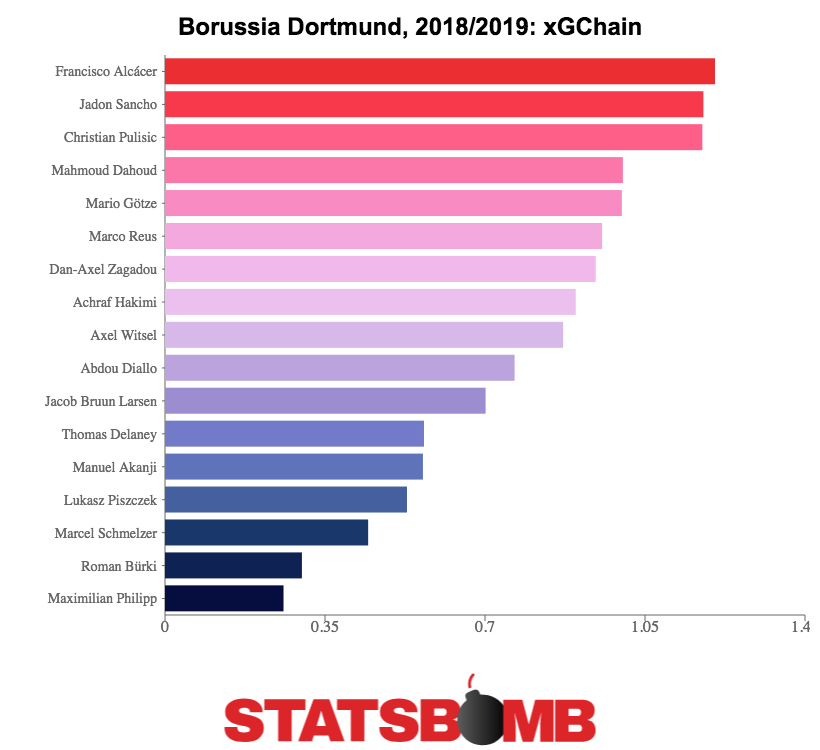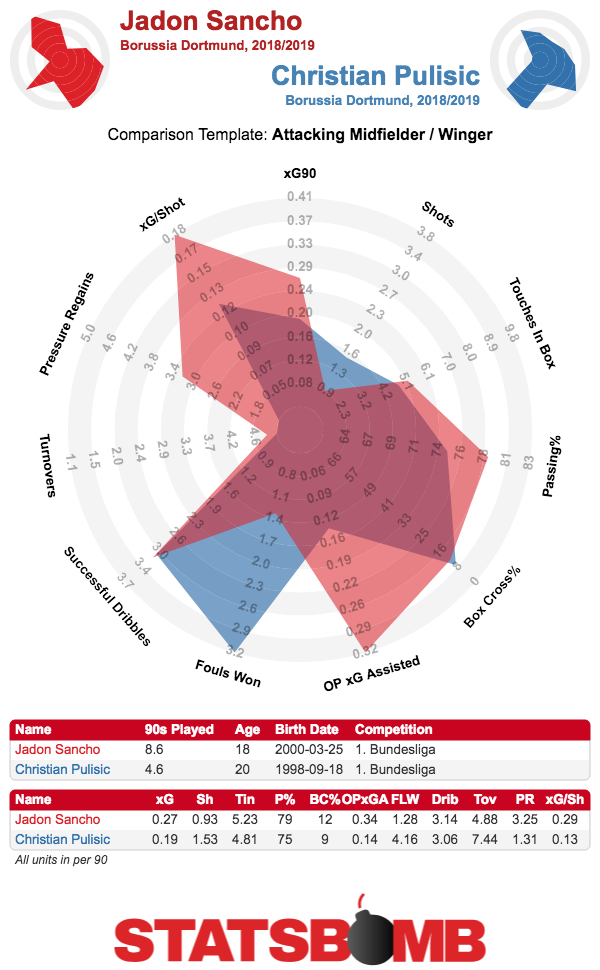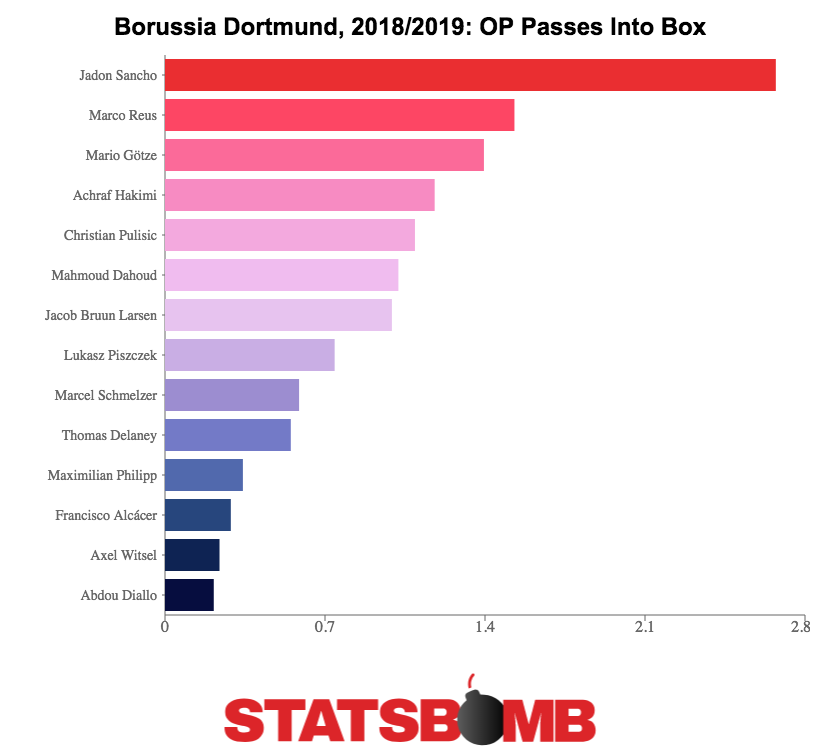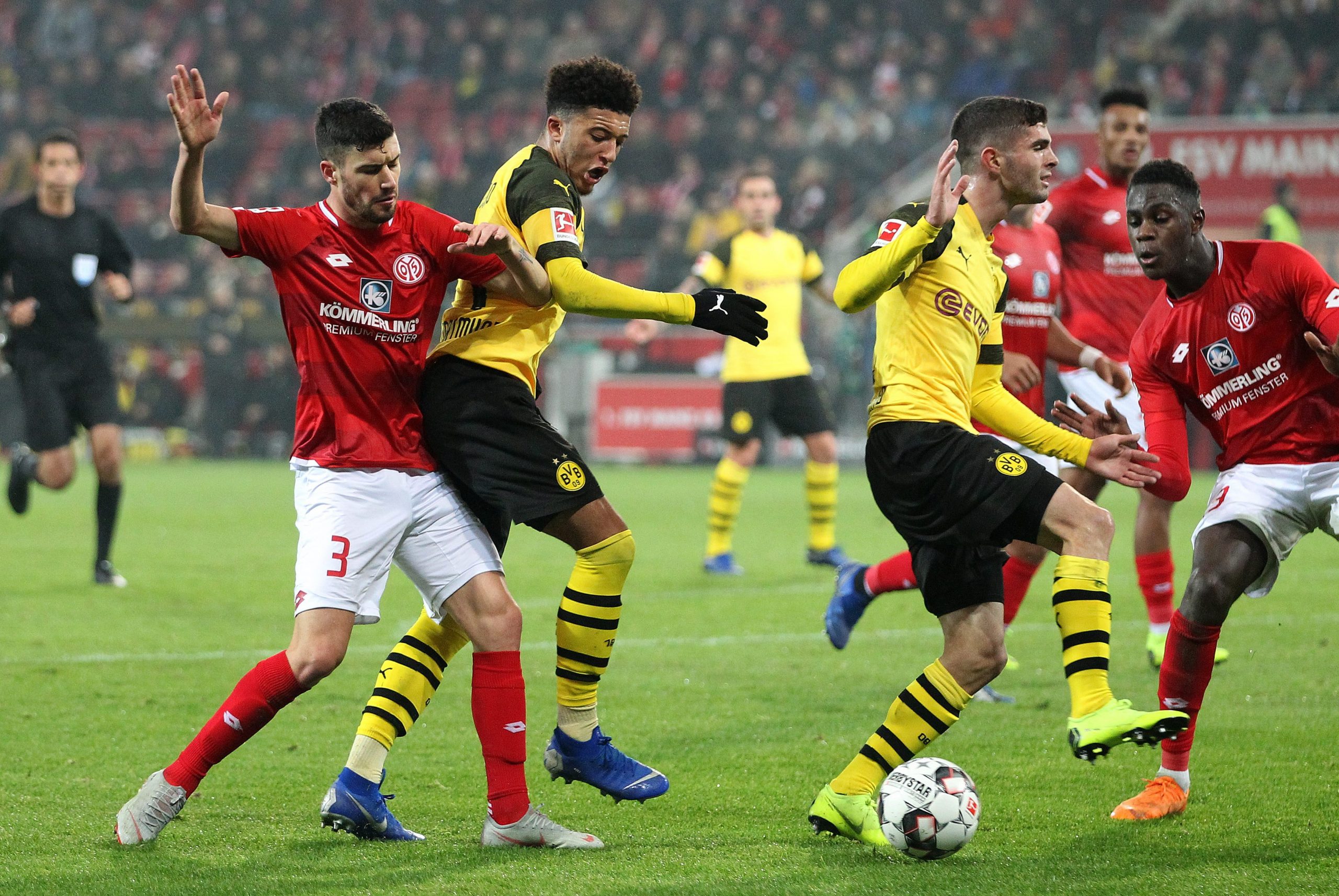The only thing people love more than heralding new, exciting young talents is discarding them for newer, more exciting young talents.
This is the story with Christian Pulisic and Jadon Sancho. Way back in the final stretches of the 2015/16 season, when it looked as though Thomas Tuchel could build a dynasty at Borussia Dortmund, a 17 year old Pulisic was beginning to receive some minutes off the bench and looking rather interesting in the process.
The following year, he managed to become a more integrated part of the side and managed to get everyone excited. The United States had produced its first great men’s soccer player. The rumours of a big money move to the Premier League were abound. The world was to have a new superstar. Then Sancho turned up in Dortmund and stole his career.
Let’s track back on that slightly.
Sancho arrived at Dortmund from Manchester City in the summer of 2017, with the then 17 year old having to wait until the second half of the season to get on the pitch, just as Pulisic did at the same age. In what was a mess of a Dortmund side, he took to the Bundesliga like a duck to water and established himself as the poster boy for young Englishmen plying their trade in Germany.
He initially started this season on the bench, but a string of great performances as a substitute ha meant he has forced his way not just into the starting eleven but has become a key player for Lucien Favre’s potential title winners. The player he displaced from the starting line up? Christian Pulisic. Let’s take a closer look at them both to see what’s going on.
Christian Pulisic
In some senses, Pulisic feels like the star of a Dortmund team that never existed. Having been signed by the club as a 16 year old back in 2015, he was clearly groomed for the kind of football we saw from the club under then manager Jürgen Klopp. With Klopp’s reign coming to an unceremonious end, Thomas Tuchel came in with broadly the same principles, albeit a greater emphasis on possession play.
While Tuchel’s first season was built around Henrikh Mkhitaryan, Marco Reus and Shinji Kagawa in the attacking midfield roles, his second saw a changing of the guard, with Pulisic and new signing Ousmane Dembélé now trusted behind Pierre-Emerick Aubameyang. Dembélé was clearly the senior partner here, setting himself up for the big move to Barcelona. But Pulisic showed himself to be well on the way to stardom, combining a terrific natural talent at dribbling through congested areas with intelligent off the ball movement.
Of course, the side’s inability to build on the previous season’s results combined with reported clashes with senior figures at the club led to the end of Tuchel’s reign, though a theoretically similarly minded figure in Peter Bosz was appointed. The less said about Bosz’s reign, the better, and he was replaced by Peter Stöger in less than ideal circumstances halfway through the season. Almost by accident, Stöger began the trend away from the club’s famed pressing game and towards a deeper counter-attacking approach, a move that has been heavily reinforced this year by Favre.
In an alternate world where Dortmund are in the fourth year of Tuchel, it’s easy to imagine Pulisic as a key player. Under Favre, he increasingly seems sidelined. So is he failing to have any impact? Well, not quite. For Dortmund, his xGChain this season remains as strong as Sancho and behind only Paco Alcácer.
He is involving himself in just as many sequences that lead to high quality chances as Sancho, albeit not in such noticeable and arguably decisive ways as the Englishman. He is dribbling a solid amount (3.06 times per 90) but his expected goals and assists remain fairly middling. Nothing about his creative passing really stands out as much as it perhaps should for his ability in the numbers. It does feel as though he has stalled.

As he matures and evolves his game, it may be that he is more suited to being a ball progressing midfielder than a wide player. In recent weeks, Pulisic has been heavily linked with both Chelsea and Liverpool.
If he were to move to Liverpool, it is easy to imagine a positional evolution similar to Alex Oxlade-Chamberlain, with the American’s skillset well suited to Klopp’s quest to turn stalling attacking midfielders into deeper ball progressors.
The Chelsea move would also have logic behind it, with Sarri’s possession heavy pressing system probably much better suited to the Favre set up. While one could see him as the most advanced midfielder in the 4-3-3, a position currently occupied by Ross Barkley, it’s easy to imagine him as a zone moving wide forward replacing Willian long term and sharing some of the burden currently taken by Eden Hazard.
This could help Hazard become the goalscoring wide forward Sarri wants him to be while replacing some of the ball progression he’s been doing in the past few years. If he goes to either of these clubs, it seems like he could have an excellent career in the Premier League. As it stands, the more ball progressing part of his skillset doesn’t seem especially useful to a Dortmund side who want to move up the pitch quickly with the speed of some of the other attacking players. Such as…

Jadon Sancho
If Favre’s arrival at the Westfalenstadion has been a hindrance to Pulisic, it might have been the best thing that could have happened to Sancho. During the player’s time in English youth football, the player was seen as something of an unpredictable dribbler, someone who could do something truly surprising at any point.
“You get a lot of players in academies who have been coached, but [Sancho] has got that natural street ability where you don't necessarily know what he is going to do before he gets the ball. He then goes and carries it past two or three players with ease”, stated former England Under 16 coach Paul Williams.
“He could be our Neymar-type player – in terms of being unpredictable, playing on that left-hand side”, claimed another former England youth coach Dan Micche. That is, of course, “provided he doesn’t become restricted”.
Favre is, of course, not a manager who likes to play “unrestricted” football. “Efficient” would be a better word to describe his approach, with his continual ability to overperform expected goals in part a feature of compact organisation and getting men behind the ball.
At Borussia Dortmund in particular, this has been accompanied by a counter attack at blistering pace, with relatively little scope for slowing down and overcomplication. This has kept him at a relatively medium 3.1 dribbles per 90, while Micche’s proposed idol Neymar puts up 4.8 and stat breaker Adama Traoré manages 5.0.
What he is doing a lot of, though, is creating chances, with Sancho assisting as many expected goals in open play per 90 as anyone else in the Bundesliga. He’s also become a key ball progressing cog, becoming comfortably Dortmund’s most frequent player to complete open play passes into the box. This is a team that are top of the Bundesliga and a not insignificant amount of their attacking plan seems to be to give the ball to this 18 year old.

It has at times felt recently as though some particularly gifted young English players have been allowed to be a little too unrestricted. Players such as Jack Wilshere and Ross Barkley have been encouraged to flourish without really being defined to specific roles and tasks, and it does feel as though it has contributed to them stalling, as Barkley himself implied when he admitted he hadn’t been coached at Everton to the extent he is right now at Chelsea.
Sancho, meanwhile, finds himself in a situation where he is being given clear instructions and responsibilities. Though Neymar is the superstar Micche suggested he should emulate, perhaps Sancho might be best off looking at the early evolution of Cristiano Ronaldo. Under the tutelage of Sir Alex Ferguson, a young Ronaldo was taught to generally simplify his game, reducing the “tricks” and becoming a more decisive footballer in the process. While it is unlikely that any player will achieve as much as Ronaldo, this does seem to be the path that he should be aiming for under Favre.
Conclusion
Predicting the path of player development is hard and fraught with elements that are difficult to control. Pulisic seemed to be blazing a path to great success before dipping somewhat in the past 18 months. Sancho is currently defying logic with his form, but it is very possible that he will see similar frustrations in the future.
A player such as Raheem Sterling spent several years unable to perform like he did at age 19 before having a sudden leap in production under Pep Guardiola. It happens. Improvement is not linear. While he has the advantage of being more suited to the style of football, it does feel right now as though Sancho has a higher ceiling than Pulisic.
That Dortmund have tied Sancho down to a new deal while apparently being open to letting Pulisic go suggests the view is the same internally. But this is not a huge indictment of Pulisic rather than an endorsement of Sancho. Both look more than capable of having terrific careers. Bear that in mind if you’re reading an article in two years’ time about how Sancho is struggling to live up to expectations.
